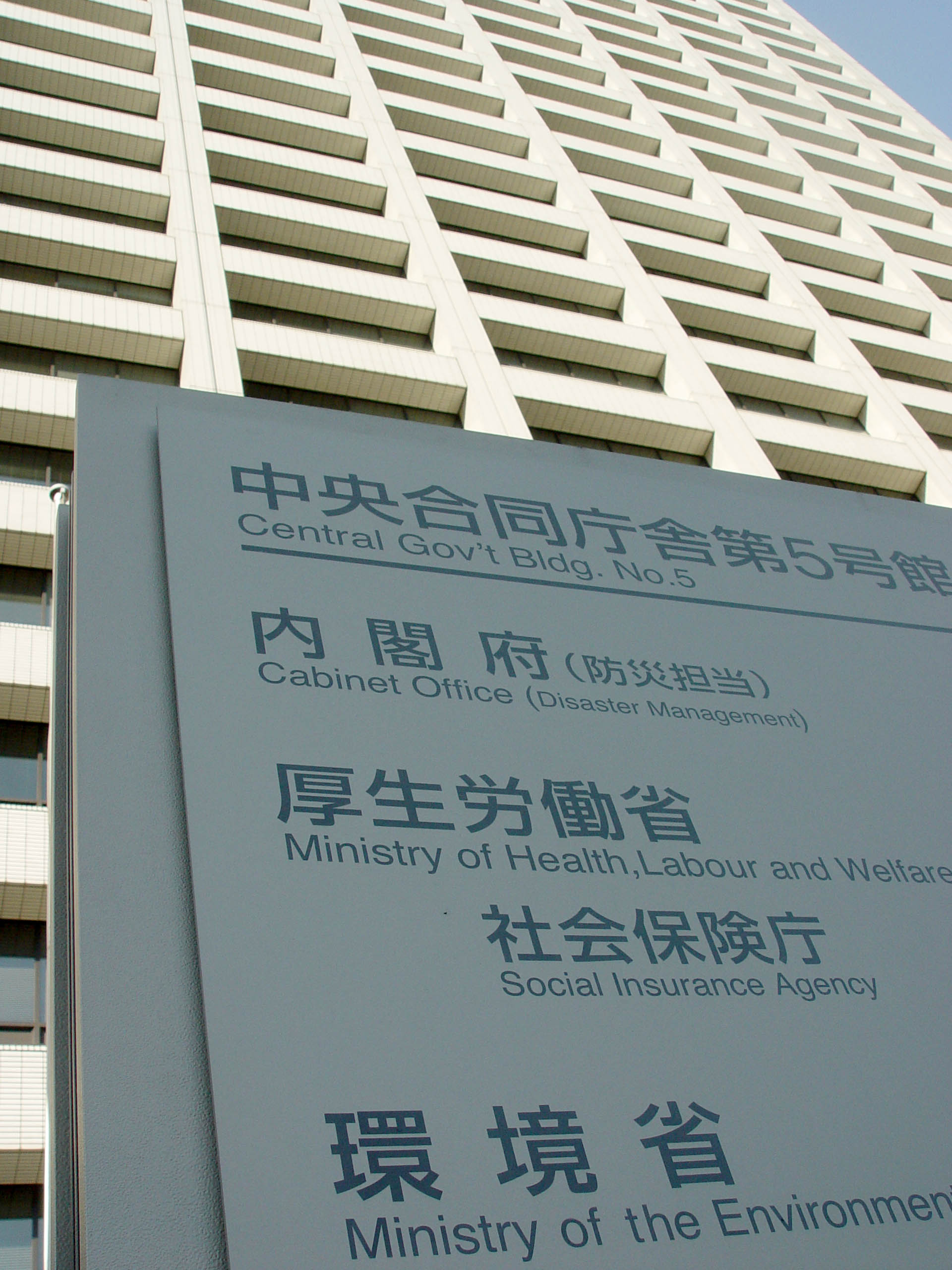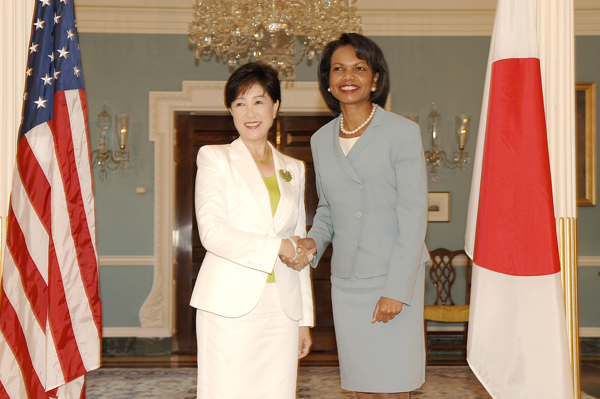|
Environment Agency Of Japan
The is a Cabinet-level ministry of the government of Japan responsible for global environmental conservation, pollution control, and nature conservation. The ministry was formed in 2001 from the sub-cabinet level Environmental Agency established in 1971. The Minister of the Environment is a member of the Cabinet of Japan and is chosen by the Prime Minister, usually from among members of the Diet. In March 2006, the then-Minister of the Environment Yuriko Koike, created a ''furoshiki'' cloth to promote its use in the modern world. In August 2011, the Cabinet of Japan approved a plan to establish a new energy watchdog under the Environment Ministry, and the Nuclear Regulation Authority was founded on September 19, 2012. Organization * Minister's Secretariat (Õż¦ĶćŻÕ«śµł┐) * (ńĘÅÕÉłńÆ░Õóāµö┐ńŁ¢ńĄ▒µŗ¼Õ«ś) * Global Environment Bureau (Õ£░ńÉāńÆ░ÕóāÕ▒Ć) * Environment Management Bureau (µ░┤Ńā╗Õż¦µ░ŚńÆ░ÕóāÕ▒Ć) * Nature Conservation Bureau (Ķć¬ńäČńÆ░ÕóāÕ▒Ć) * (ńÆ░ÕóāÕåŹńö¤Ńā╗Ķ│ćµ║ÉÕŠ¬ń ... [...More Info...] [...Related Items...] OR: [Wikipedia] [Google] [Baidu] |
Government Of Japan
The Government of Japan consists of legislative, executive and judiciary branches and is based on popular sovereignty. The Government runs under the framework established by the Constitution of Japan, adopted in 1947. It is a unitary state, containing forty-seven administrative divisions, with the Emperor as its Head of State. His role is ceremonial and he has no powers related to Government. Instead, it is the Cabinet, comprising the Ministers of State and the Prime Minister, that directs and controls the Government and the civil service. The Cabinet has the executive power and is formed by the Prime Minister, who is the Head of Government. The Prime Minister is nominated by the National Diet and appointed to office by the Emperor. The National Diet is the legislature, the organ of the Legislative branch. It is bicameral, consisting of two houses with the House of Councilors being the upper house, and the House of Representatives being the lower house. Its members are direc ... [...More Info...] [...Related Items...] OR: [Wikipedia] [Google] [Baidu] |
Yuriko Koike
is a Japanese politician who currently serves as the Governor of Tokyo since 2016. She graduated from the American University in Cairo in 1976 and was a member of the House of Representatives of Japan from 1993 until 2016, when she resigned to run for Governor of Tokyo. She also previously served as Minister of the Environment in the Junichiro Koizumi cabinet from 2003 to 2006 and briefly as Minister of Defense in the first cabinet of Shinz┼Ź Abe in 2007.Koike decides to leave post, cites responsibility over information leak , JapanNewsReview.com; accessed 18 June 2015. Koike was |
Environment Ministries
Environment most often refers to: __NOTOC__ * Natural environment, all living and non-living things occurring naturally * Biophysical environment, the physical and biological factors along with their chemical interactions that affect an organism or a group of organisms Other physical and cultural environments *Ecology, the branch of ethology that deals with the relations of organisms to one another and to their physical surroundings *Environment (systems), the surroundings of a physical system that may interact with the system by exchanging mass, energy, or other properties *Built environment, constructed surroundings that provide the setting for human activity, ranging from the large-scale civic surroundings to the personal places *Social environment, the culture that an individual lives in, and the people and institutions with whom they interact *Market environment, business term Arts, entertainment and publishing * ''Environment'' (magazine), a peer-reviewed, popular envir ... [...More Info...] [...Related Items...] OR: [Wikipedia] [Google] [Baidu] |
Ministries Established In 2001
Ministry may refer to: Government * Ministry (collective executive), the complete body of government ministers under the leadership of a prime minister * Ministry (government department), a department of a government Religion * Christian ministry, activity by Christians to spread or express their faith ** Minister (Christianity), clergy authorized by a church or religious organization to perform teaching or rituals ** Ordination, the process by which individuals become clergy * Ministry of Jesus, activities described in the Christian gospels * ''Ministry'' (magazine), a magazine for pastors published by the Seventh-day Adventist Church Music * Ministry (band), an American industrial metal band * Ministry of Sound, a London nightclub and record label Fiction * Ministry (comics), a horror comic book created by writer-artist Lara J. Phillips * Ministry of Magic, governing body in the ''Harry Potter'' series * Ministry of Darkness, a professional wrestling stable led by Th ... [...More Info...] [...Related Items...] OR: [Wikipedia] [Google] [Baidu] |
2001 Establishments In Japan
1 (one, unit, unity) is a number representing a single or the only entity. 1 is also a numerical digit and represents a single unit of counting or measurement. For example, a line segment of ''unit length'' is a line segment of length 1. In conventions of sign where zero is considered neither positive nor negative, 1 is the first and smallest positive integer. It is also sometimes considered the first of the infinite sequence of natural numbers, followed by 2, although by other definitions 1 is the second natural number, following 0. The fundamental mathematical property of 1 is to be a multiplicative identity, meaning that any number multiplied by 1 equals the same number. Most if not all properties of 1 can be deduced from this. In advanced mathematics, a multiplicative identity is often denoted 1, even if it is not a number. 1 is by convention not considered a prime number; this was not universally accepted until the mid-20th century. Additionally, 1 is the s ... [...More Info...] [...Related Items...] OR: [Wikipedia] [Google] [Baidu] |
Environmental Issues In Japan
Environmental pollution in Japan has accompanied industrialization since the Meiji period. One of the earliest cases was the copper poisoning caused by drainage from the Ashio Copper Mine in Tochigi Prefecture, beginning as early as 1878. Repeated floods occurred in the Watarase River basin, and 1,600 hectares of farmland and towns and villages in Tochigi and Gunma prefectures were damaged by the floodwater, which contained excessive inorganic copper compounds from the Ashio mine. The local breeders led by Sh┼Źz┼Ź Tanaka, a member of the Lower House from Tochigi appealed to the prefecture and the government to call a halt to the mining operations. Although the mining company paid compensatory money and the government engaged in the embankment works of the Watarase River, no fundamental solution of the problem was achieved. Japan is the world's leading importer of both exhaustible and renewable natural resources and one of the largest consumers of fossil fuels. Environment d ... [...More Info...] [...Related Items...] OR: [Wikipedia] [Google] [Baidu] |
2011 T┼Źhoku Earthquake And Tsunami
The occurred at 14:46 JST (05:46 UTC) on 11 March. The magnitude 9.0ŌĆō9.1 (M) undersea megathrust earthquake had an epicenter in the Pacific Ocean, east of the Oshika Peninsula of the T┼Źhoku region, and lasted approximately six minutes, causing a tsunami. It is sometimes known in Japan as the , among other names. The disaster is often referred to in both Japanese and English as simply 3.11 (read in Japanese). It was the most powerful earthquake ever recorded in Japan, and the fourth most powerful earthquake in the world since modern record-keeping began in 1900. The earthquake triggered powerful tsunami waves that may have reached heights of up to in Miyako in T┼Źhoku's Iwate Prefecture,Yomiuri Shimbun evening edition 2-11-04-15 page 15, nearby Aneyoshi fishery port (Õ¦ēÕÉēµ╝üµĖ»)(Google map E39 31 57.8, N 142 3 7.6) 2011-04-15Õż¦ķ£ćńüĮŃü«µ┤źµ│óŃĆüÕ««ÕÅżŃü¦38.9 mŌĆ”µśÄµ▓╗õĖēķÖĖõĖŖÕø×Ńéŗby okayasu Akio (Õ▓ĪÕ«ē ń½ĀÕż½) and which, in the Sendai area, traveled at a ... [...More Info...] [...Related Items...] OR: [Wikipedia] [Google] [Baidu] |
Junichiro Koizumi
Junichiro Koizumi (; , ''Koizumi Jun'ichir┼Ź'' ; born 8 January 1942) is a former Japanese politician who was Prime Minister of Japan and President of the Liberal Democratic Party (LDP) from 2001 to 2006. He retired from politics in 2009. He is the sixth-longest serving Prime Minister in Japanese history. Widely seen as a maverick leader of the LDP upon his election to the position in 2001, he became known as a neoliberal economic reformer, focusing on reducing Japan's government debt and the privatisation of its postal service. In the 2005 election, Koizumi led the LDP to win one of the largest parliamentary majorities in modern Japanese history. Koizumi also attracted international attention through his deployment of the Japan Self-Defense Forces to Iraq, and through his visits to the Yasukuni Shrine that fueled diplomatic tensions with neighbouring China and South Korea. Koizumi resigned as Prime Minister in 2006. Although Koizumi maintained a low profile for several years ... [...More Info...] [...Related Items...] OR: [Wikipedia] [Google] [Baidu] |
Cool Biz Campaign
The Cool Biz campaign is a Japanese campaign initiated by the Japanese Ministry of the Environment from summer 2005 as a means to help reduce Japanese electricity consumption by limiting the use of air conditioning. This was enabled by changing the standard office air conditioner temperature to 28 ┬░C (or about 82 ┬░F) and introducing a liberal summer dress code in the bureaucracy of the Japanese government so staff could work in the warmer temperature. The campaign then spread to the private sector. This idea was proposed by the then- Minister Yuriko Koike under the cabinet of Prime Minister Junichir┼Ź Koizumi. Initially the campaign was from June to September, but from 2011, when there were electricity shortages after the 2011 T┼Źhoku earthquake and tsunami it was lengthened. It now runs from May to October. Plan According to the Ministry of the Environment, central government ministries were to set air conditioner temperatures at 28 ┬░C until September. The Cool ... [...More Info...] [...Related Items...] OR: [Wikipedia] [Google] [Baidu] |
Nuclear Regulation Authority
The is an administrative body of the Cabinet of Japan established to ensure nuclear safety in Japan as part of the Ministry of the Environment. Established on September 19, 2012, its first head was Shunichi Tanaka. Background The NRA was formed from the Nuclear Safety Commission, which came under the authority of the Cabinet, and the Nuclear and Industrial Safety Agency, which was under the Ministry of Economy, Trade and Industry (METI). After the Fukushima nuclear disaster following the March 11, 2011, earthquake, the government's safety measures were seen to be inadequate. Also, NISA, being under the umbrella of METI, which was also responsible for promoting the use of nuclear power, was seen as having a conflict of interest. As a consequence, the new agency was established under the Ministry of the Environment. Early days According to the law establishing the NRA, the task of working out new nuclear safety rules must be completed within ten months of its September 19, 201 ... [...More Info...] [...Related Items...] OR: [Wikipedia] [Google] [Baidu] |
Japan Today
''Japan Today'' is a website that publishes wire articles, press releases, and photographs, as well as opinion and contract pieces, such as company profiles, in English. References External links * 2000 establishments in Japan English-language newspapers published in Japan Newspapers published in Tokyo Newspapers established in 2000 {{Japan-newspaper-stub ... [...More Info...] [...Related Items...] OR: [Wikipedia] [Google] [Baidu] |
Furoshiki
are traditional Japanese wrapping cloths traditionally used to wrap and/or to transport goods. Consideration is placed on the aesthetics of , which may feature hemmed edges, thicker and more expensive materials, and hand-painted designs; however, are much less formal than , and are not generally used to present formal gifts. While they come in a variety of sizes, they are typically square. Traditional materials include silk or cotton, but modern are available in synthetic materials like rayon, nylon, or polyester. History The first cloths were ("wrapping"), used during the Nara period as protection for precious temple objects. By the Heian period, cloths called , meaning "flat wrap", were used to wrap clothes. These cloths came to be known as during the Muromachi period; the term (literally "bath spread", from , and ) is said to have come about after high-ranking visitors to bathhouses packed their belongings in cloth decorated with their family crest. They became ... [...More Info...] [...Related Items...] OR: [Wikipedia] [Google] [Baidu] |





